weight FORD F-600 2022 Owners Manual
[x] Cancel search | Manufacturer: FORD, Model Year: 2022, Model line: F-600, Model: FORD F-600 2022Pages: 740, PDF Size: 12.6 MB
Page 13 of 740
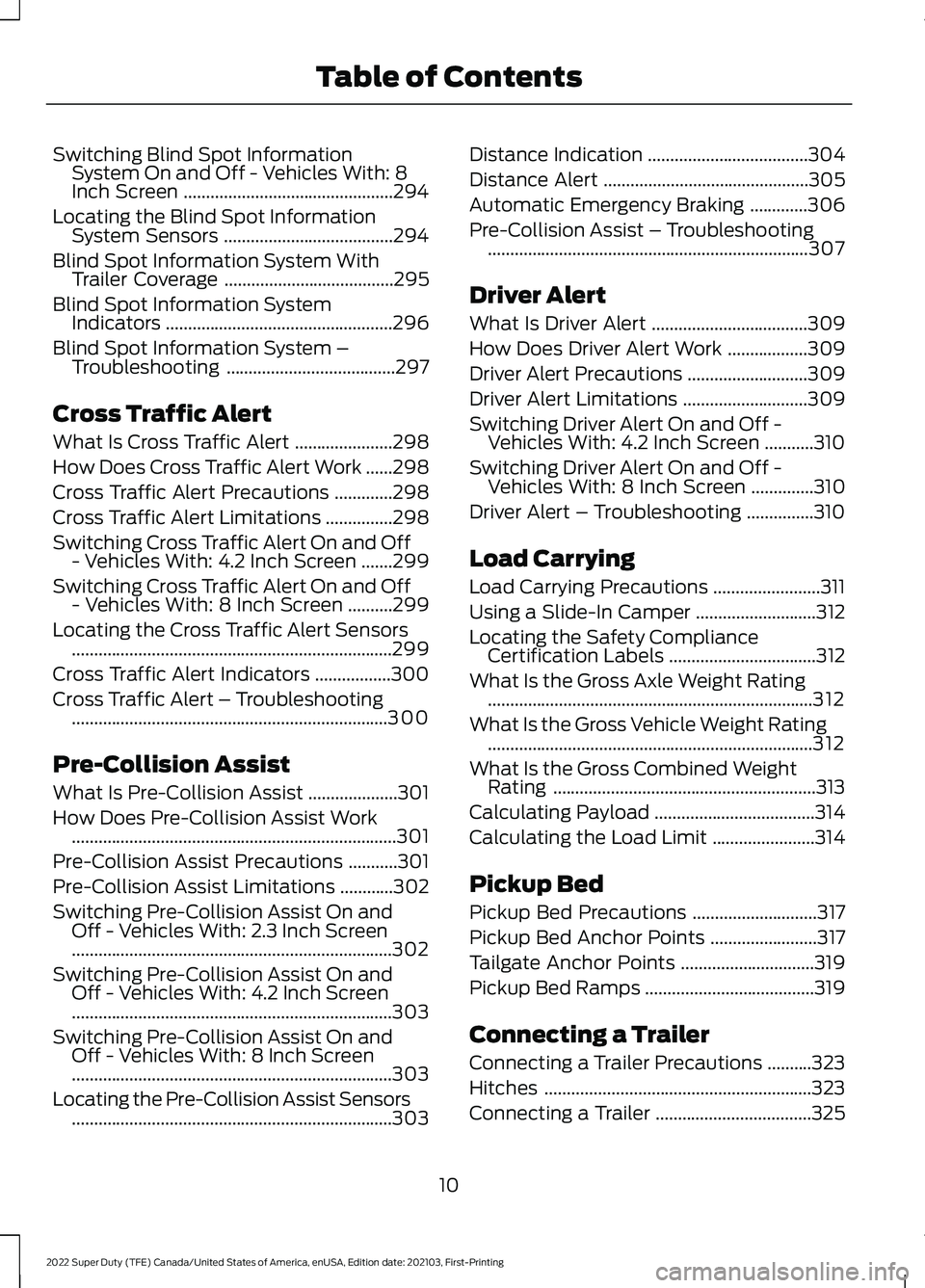
Switching Blind Spot Information
System On and Off - Vehicles With: 8
Inch Screen ...............................................294
Locating the Blind Spot Information System Sensors ......................................
294
Blind Spot Information System With Trailer Coverage ......................................
295
Blind Spot Information System Indicators ...................................................
296
Blind Spot Information System – Troubleshooting ......................................
297
Cross Traffic Alert
What Is Cross Traffic Alert ......................
298
How Does Cross Traffic Alert Work ......
298
Cross Traffic Alert Precautions .............
298
Cross Traffic Alert Limitations ...............
298
Switching Cross Traffic Alert On and Off - Vehicles With: 4.2 Inch Screen .......
299
Switching Cross Traffic Alert On and Off - Vehicles With: 8 Inch Screen ..........
299
Locating the Cross Traffic Alert Sensors ........................................................................\
299
Cross Traffic Alert Indicators .................
300
Cross Traffic Alert – Troubleshooting .......................................................................
300
Pre-Collision Assist
What Is Pre-Collision Assist ....................
301
How Does Pre-Collision Assist Work ........................................................................\
.
301
Pre-Collision Assist Precautions ...........
301
Pre-Collision Assist Limitations ............
302
Switching Pre-Collision Assist On and Off - Vehicles With: 2.3 Inch Screen
........................................................................\
302
Switching Pre-Collision Assist On and Off - Vehicles With: 4.2 Inch Screen
........................................................................\
303
Switching Pre-Collision Assist On and Off - Vehicles With: 8 Inch Screen
........................................................................\
303
Locating the Pre-Collision Assist Sensors ........................................................................\
303 Distance Indication
....................................
304
Distance Alert ..............................................
305
Automatic Emergency Braking .............
306
Pre-Collision Assist – Troubleshooting ........................................................................\
307
Driver Alert
What Is Driver Alert ...................................
309
How Does Driver Alert Work ..................
309
Driver Alert Precautions ...........................
309
Driver Alert Limitations ............................
309
Switching Driver Alert On and Off - Vehicles With: 4.2 Inch Screen ...........
310
Switching Driver Alert On and Off - Vehicles With: 8 Inch Screen ..............
310
Driver Alert – Troubleshooting ...............
310
Load Carrying
Load Carrying Precautions ........................
311
Using a Slide-In Camper ...........................
312
Locating the Safety Compliance Certification Labels .................................
312
What Is the Gross Axle Weight Rating ........................................................................\
.
312
What Is the Gross Vehicle Weight Rating ........................................................................\
.
312
What Is the Gross Combined Weight Rating ...........................................................
313
Calculating Payload ....................................
314
Calculating the Load Limit .......................
314
Pickup Bed
Pickup Bed Precautions ............................
317
Pickup Bed Anchor Points ........................
317
Tailgate Anchor Points ..............................
319
Pickup Bed Ramps ......................................
319
Connecting a Trailer
Connecting a Trailer Precautions ..........
323
Hitches ............................................................
323
Connecting a Trailer ...................................
325
10
2022 Super Duty (TFE) Canada/United States of America, enUSA, Edition date: 202103, First-Printing Table of Contents
Page 14 of 740

Connecting a Trailer – Troubleshooting
........................................................................\
.327
Towing a Trailer
Towing a Trailer Precautions ..................
328
Trailer Brake Precautions .........................
328
Towing a Trailer Limitations ...................
329
Loading Your Trailer ...................................
329
Trailer Towing Hints ...................................
329
Launching or Retrieving a Boat or Personal Watercraft ..............................
330
Towing Weights and Dimensions ..........
331
Towing a Trailer – Troubleshooting ......
333
Integrated Trailer Brake Controller
What Is the Integrated Trailer Brake Controller ...................................................
334
Integrated Trailer Brake Controller Precautions ...............................................
334
Using the Integrated Trailer Brake Controller ...................................................
334
Adjusting the Integrated Trailer Brake Controller Mode ......................................
335
Integrated Trailer Brake Controller – Troubleshooting ......................................
336
Trailer Sway Control
How Does Trailer Sway Control Work ........................................................................\
338
Trailer Sway Control Precautions .........
338
Switching Trailer Sway Control On and Off ................................................................
338
Trailer Backup Assistance
What is Trailer Backup Assistance .......
339
How Does Trailer Backup Assistance Work ............................................................
339
Trailer Backup Assistance Precautions ........................................................................\
339
Setting Up the Trailer Backup Assistance for a Conventional Trailer ....................
339Setting Up the Trailer Backup Assistance
for a Fifth-Wheel or Gooseneck Trailer
........................................................................\
343
Switching Trailer Backup Assistance On and Off .......................................................
346
Using the Trailer Backup Assistance Controller ..................................................
346
Using the Trailer Backup Assistance Views ...........................................................
347
Trailer Backup Assistance – Troubleshooting .....................................
349
Trailer Reverse Guidance
What Is Trailer Reverse Guidance .........
357
How Does Trailer Reverse Guidance Work .............................................................
357
Trailer Reverse Guidance Precautions ........................................................................\
357
Setting Up Trailer Reverse Guidance for a Conventional Trailer ...........................
357
Setting Up Trailer Reverse Guidance for a Fifth-Wheel or Gooseneck Trailer
.......................................................................
360
Switching Trailer Reverse Guidance On and Off .......................................................
362
Using Trailer Reverse Guidance Views ........................................................................\
363
Trailer Reverse Guidance – Troubleshooting .....................................
364
Driving Hints
Off-Road Driving ..........................................
371
Cold Weather Precautions .......................
373
Breaking-In ....................................................
373
Driving Economically .................................
373
Driving Through Shallow Water .............
373
Floor Mats ......................................................
374
Snow Plowing
Snow Plowing Precautions .....................
376
Operating Your Vehicle With a Snowplow .................................................
376
11
2022 Super Duty (TFE) Canada/United States of America, enUSA, Edition date: 202103, First-Printing Table of Contents
Page 38 of 740
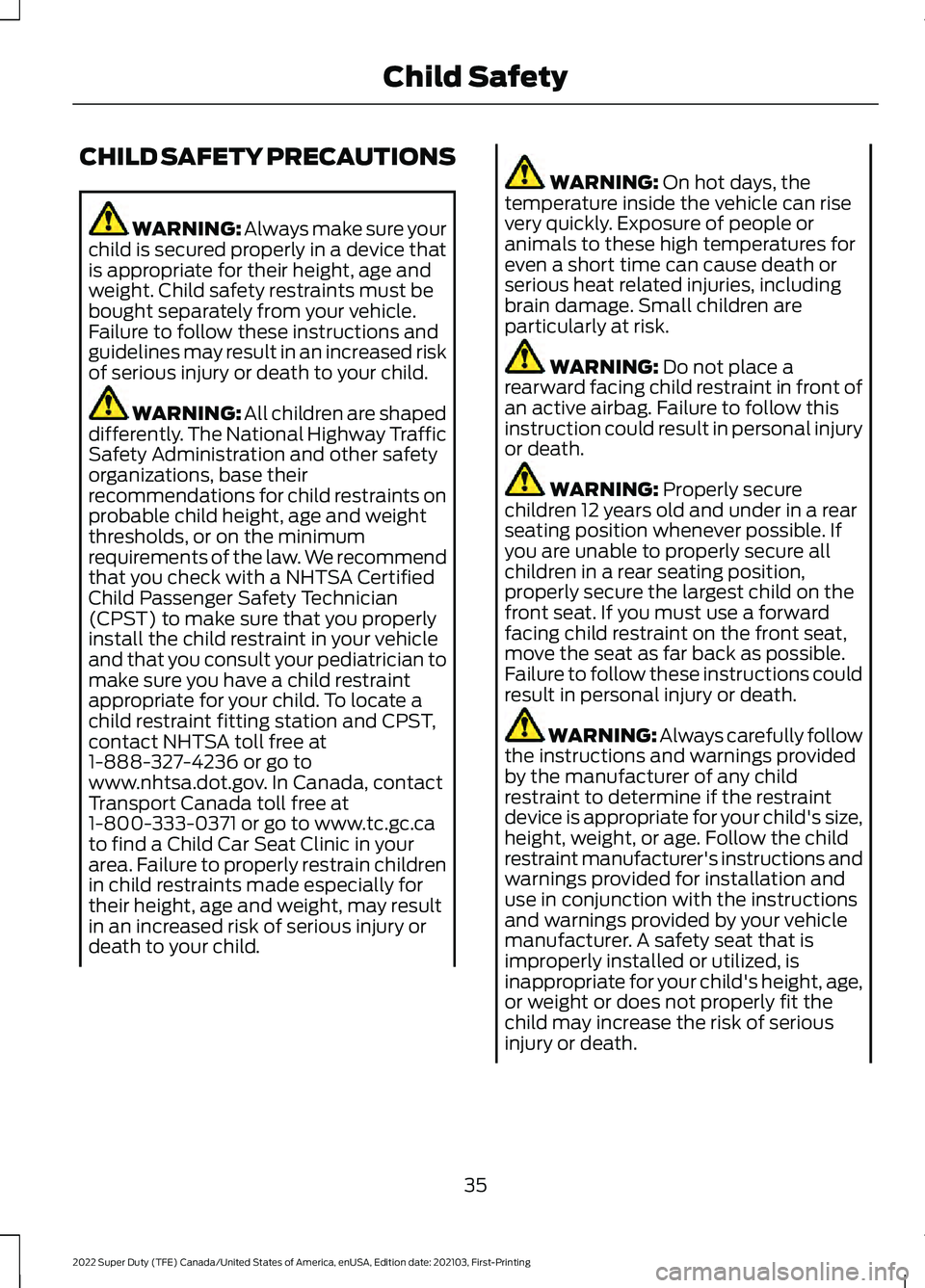
CHILD SAFETY PRECAUTIONS
WARNING: Always make sure your
child is secured properly in a device that
is appropriate for their height, age and
weight. Child safety restraints must be
bought separately from your vehicle.
Failure to follow these instructions and
guidelines may result in an increased risk
of serious injury or death to your child. WARNING: All children are shaped
differently. The National Highway Traffic
Safety Administration and other safety
organizations, base their
recommendations for child restraints on
probable child height, age and weight
thresholds, or on the minimum
requirements of the law. We recommend
that you check with a NHTSA Certified
Child Passenger Safety Technician
(CPST) to make sure that you properly
install the child restraint in your vehicle
and that you consult your pediatrician to
make sure you have a child restraint
appropriate for your child. To locate a
child restraint fitting station and CPST,
contact NHTSA toll free at
1-888-327-4236 or go to
www.nhtsa.dot.gov. In Canada, contact
Transport Canada toll free at
1-800-333-0371 or go to www.tc.gc.ca
to find a Child Car Seat Clinic in your
area. Failure to properly restrain children
in child restraints made especially for
their height, age and weight, may result
in an increased risk of serious injury or
death to your child. WARNING:
On hot days, the
temperature inside the vehicle can rise
very quickly. Exposure of people or
animals to these high temperatures for
even a short time can cause death or
serious heat related injuries, including
brain damage. Small children are
particularly at risk. WARNING:
Do not place a
rearward facing child restraint in front of
an active airbag. Failure to follow this
instruction could result in personal injury
or death. WARNING:
Properly secure
children 12 years old and under in a rear
seating position whenever possible. If
you are unable to properly secure all
children in a rear seating position,
properly secure the largest child on the
front seat. If you must use a forward
facing child restraint on the front seat,
move the seat as far back as possible.
Failure to follow these instructions could
result in personal injury or death. WARNING: Always carefully follow
the instructions and warnings provided
by the manufacturer of any child
restraint to determine if the restraint
device is appropriate for your child's size,
height, weight, or age. Follow the child
restraint manufacturer's instructions and
warnings provided for installation and
use in conjunction with the instructions
and warnings provided by your vehicle
manufacturer. A safety seat that is
improperly installed or utilized, is
inappropriate for your child's height, age,
or weight or does not properly fit the
child may increase the risk of serious
injury or death.
35
2022 Super Duty (TFE) Canada/United States of America, enUSA, Edition date: 202103, First-Printing Child Safety
Page 41 of 740
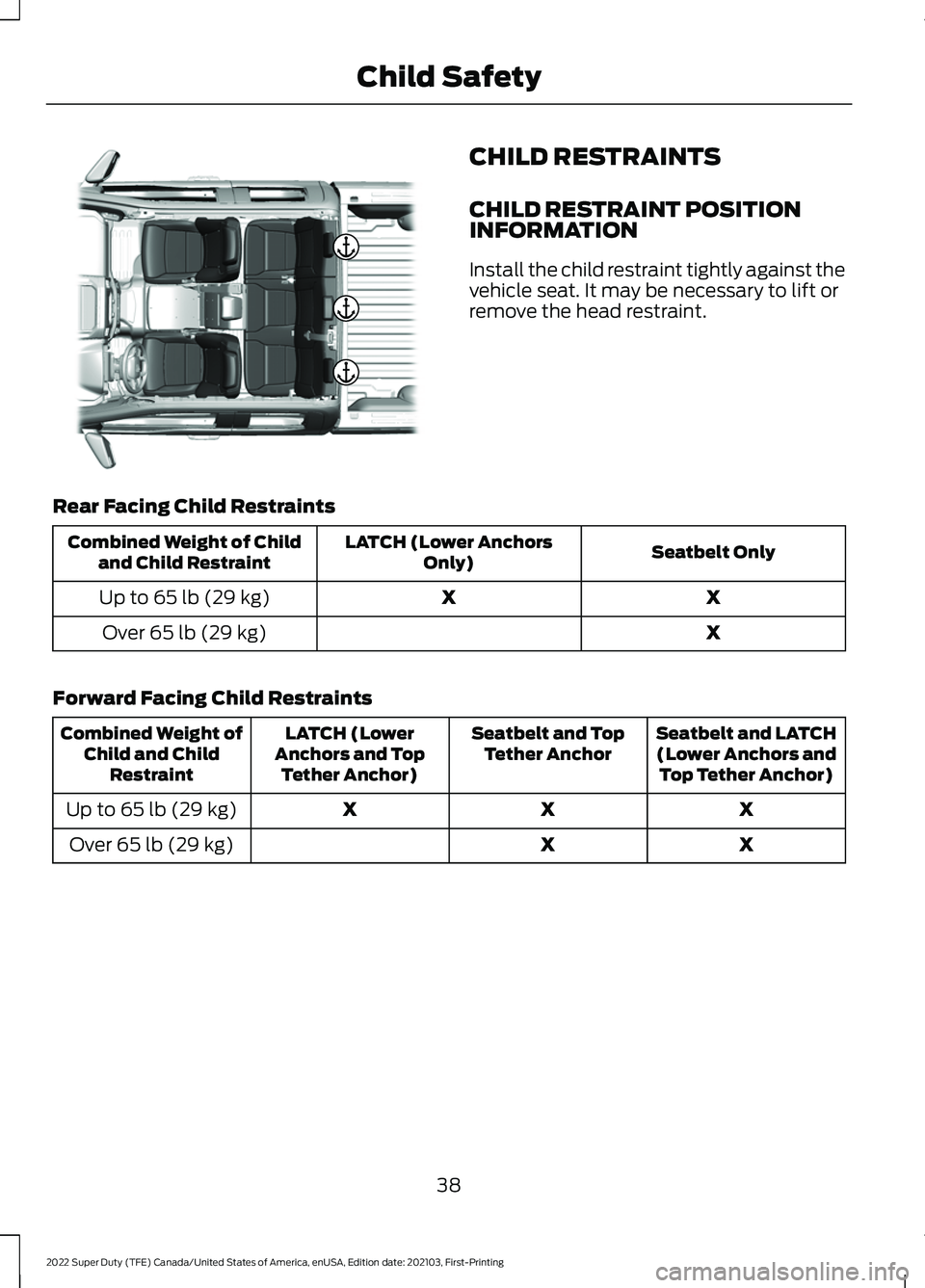
CHILD RESTRAINTS
CHILD RESTRAINT POSITION
INFORMATION
Install the child restraint tightly against the
vehicle seat. It may be necessary to lift or
remove the head restraint.
Rear Facing Child Restraints Seatbelt Only
LATCH (Lower Anchors
Only)
Combined Weight of Child
and Child Restraint
X
X
Up to 65 lb (29 kg)
X
Over
65 lb (29 kg)
Forward Facing Child Restraints Seatbelt and LATCH
(Lower Anchors and Top Tether Anchor)
Seatbelt and Top
Tether Anchor
LATCH (Lower
Anchors and Top Tether Anchor)
Combined Weight of
Child and Child Restraint
X
X
X
Up to
65 lb (29 kg)
X
X
Over
65 lb (29 kg)
38
2022 Super Duty (TFE) Canada/United States of America, enUSA, Edition date: 202103, First-Printing Child SafetyE308396
Page 42 of 740

CHILD RESTRAINTS RECOMMENDATION
Recommended Restraint Type
Child Size, Height, Weight, or Age
Use a child restraint (sometimes
called an infant carrier, convertible seat, or toddler seat).
Children weighing 40 lb (18 kg) or less (generally
age four or younger).
Use a belt-positioning boosterseat.
Children who have outgrown or no longer properly
fit in a child restraint (generally children who areless than
57 in (1.45 m) tall, are greater than age
four and less than age 12, and between 40 lb (18 kg) and
80 lb (36 kg) and upward to 100 lb (45 kg) if
recommended by your child restraint manufacturer).
Use a vehicle seatbelt having thelap belt snug and low across the
hips, shoulder belt centered across the shoulder and chest, and seat backrest upright.
Children who have outgrown or no longer properly
fit in a belt-positioning booster seat (generally chil- dren who are at least
57 in (1.45 m) tall or greater
than 80 lb (36 kg) or 100 lb (45 kg) if recommended by child restraint manufacturer).
You are required by law to properly use
child restraints for infants and toddlers in
the United States, Canada and Mexico.
Many states and provinces require that
small children use approved booster seats
until they reach age eight, a height of 57 in
(1.45 m)
tall, or 80 lb (36 kg). Check your
local and state or provincial laws for
specific requirements about the safety of
children in your vehicle.
When possible, properly restrain children
12 years of age and under in a rear seating
position of your vehicle. Accident statistics
suggest that children are safer when
properly restrained in the rear seating
positions than in a front seating position.
When installing a rear facing child restraint,
adjust the vehicle seats to avoid
interference between the child restraint
and the vehicle seat in front of the child
restraint. INSTALLING CHILD
RESTRAINTS
USING SEATBELTS WARNING:
Depending on where
you secure a child restraint, and
depending on the child restraint design,
you may block access to certain seatbelt
buckle assemblies and LATCH lower
anchors, rendering those features
potentially unusable. To avoid risk of
injury, make sure occupants only use
seating positions where they are able to
be properly restrained.
Note: The following does not apply to the
front center position of Super Cab and Crew
Cab vehicles.
Note: Although the child restraint
illustrated is a forward facing child restraint,
the steps are the same for installing a rear
facing child restraint.
39
2022 Super Duty (TFE) Canada/United States of America, enUSA, Edition date: 202103, First-Printing Child Safety
Page 44 of 740
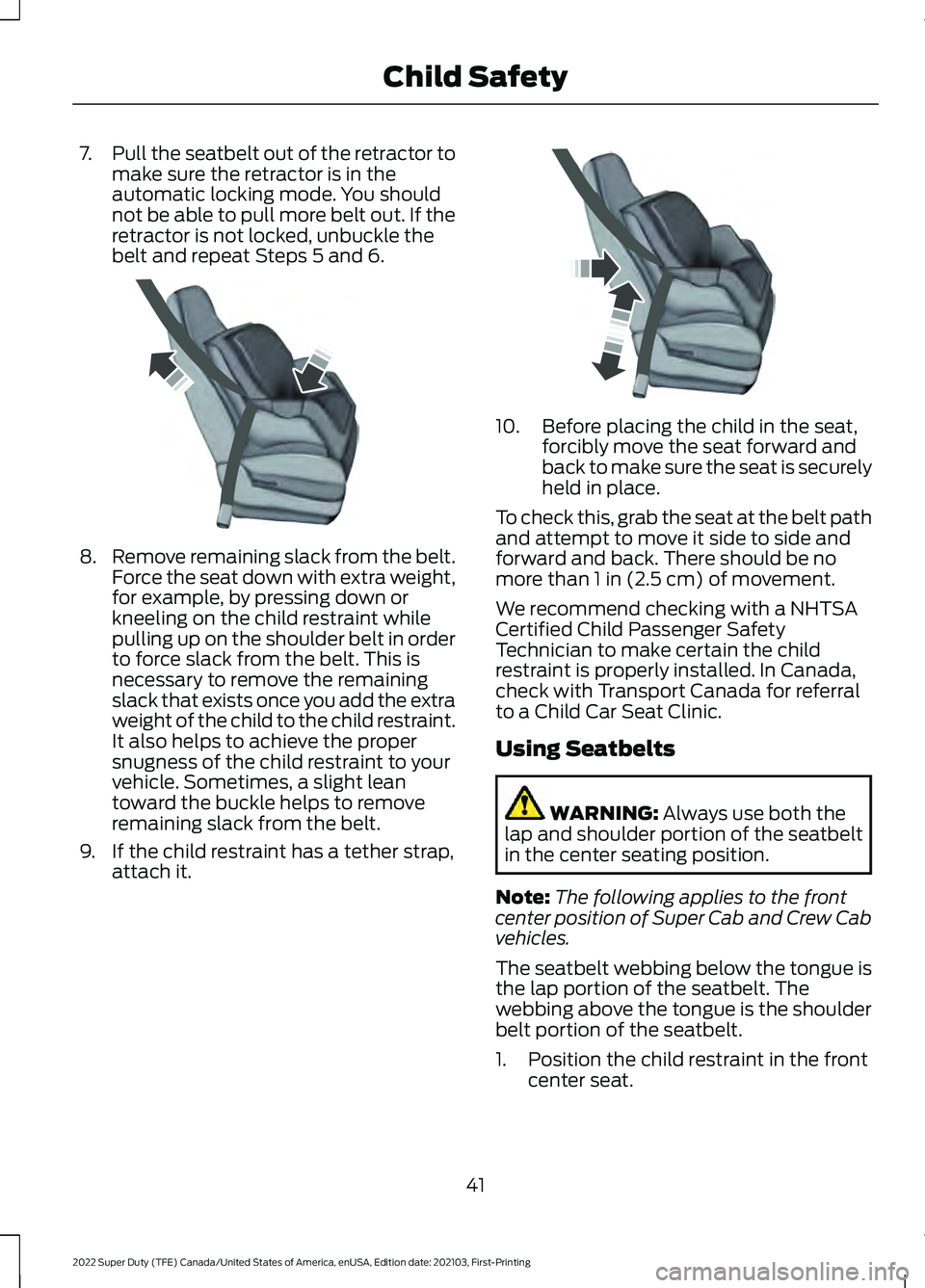
7.
Pull the seatbelt out of the retractor to
make sure the retractor is in the
automatic locking mode. You should
not be able to pull more belt out. If the
retractor is not locked, unbuckle the
belt and repeat Steps 5 and 6. 8.
Remove remaining slack from the belt.
Force the seat down with extra weight,
for example, by pressing down or
kneeling on the child restraint while
pulling up on the shoulder belt in order
to force slack from the belt. This is
necessary to remove the remaining
slack that exists once you add the extra
weight of the child to the child restraint.
It also helps to achieve the proper
snugness of the child restraint to your
vehicle. Sometimes, a slight lean
toward the buckle helps to remove
remaining slack from the belt.
9. If the child restraint has a tether strap, attach it. 10. Before placing the child in the seat,
forcibly move the seat forward and
back to make sure the seat is securely
held in place.
To check this, grab the seat at the belt path
and attempt to move it side to side and
forward and back. There should be no
more than 1 in (2.5 cm) of movement.
We recommend checking with a NHTSA
Certified Child Passenger Safety
Technician to make certain the child
restraint is properly installed. In Canada,
check with Transport Canada for referral
to a Child Car Seat Clinic.
Using Seatbelts WARNING:
Always use both the
lap and shoulder portion of the seatbelt
in the center seating position.
Note: The following applies to the front
center position of Super Cab and Crew Cab
vehicles.
The seatbelt webbing below the tongue is
the lap portion of the seatbelt. The
webbing above the tongue is the shoulder
belt portion of the seatbelt.
1. Position the child restraint in the front center seat.
41
2022 Super Duty (TFE) Canada/United States of America, enUSA, Edition date: 202103, First-Printing Child SafetyE142533 E142534
Page 161 of 740
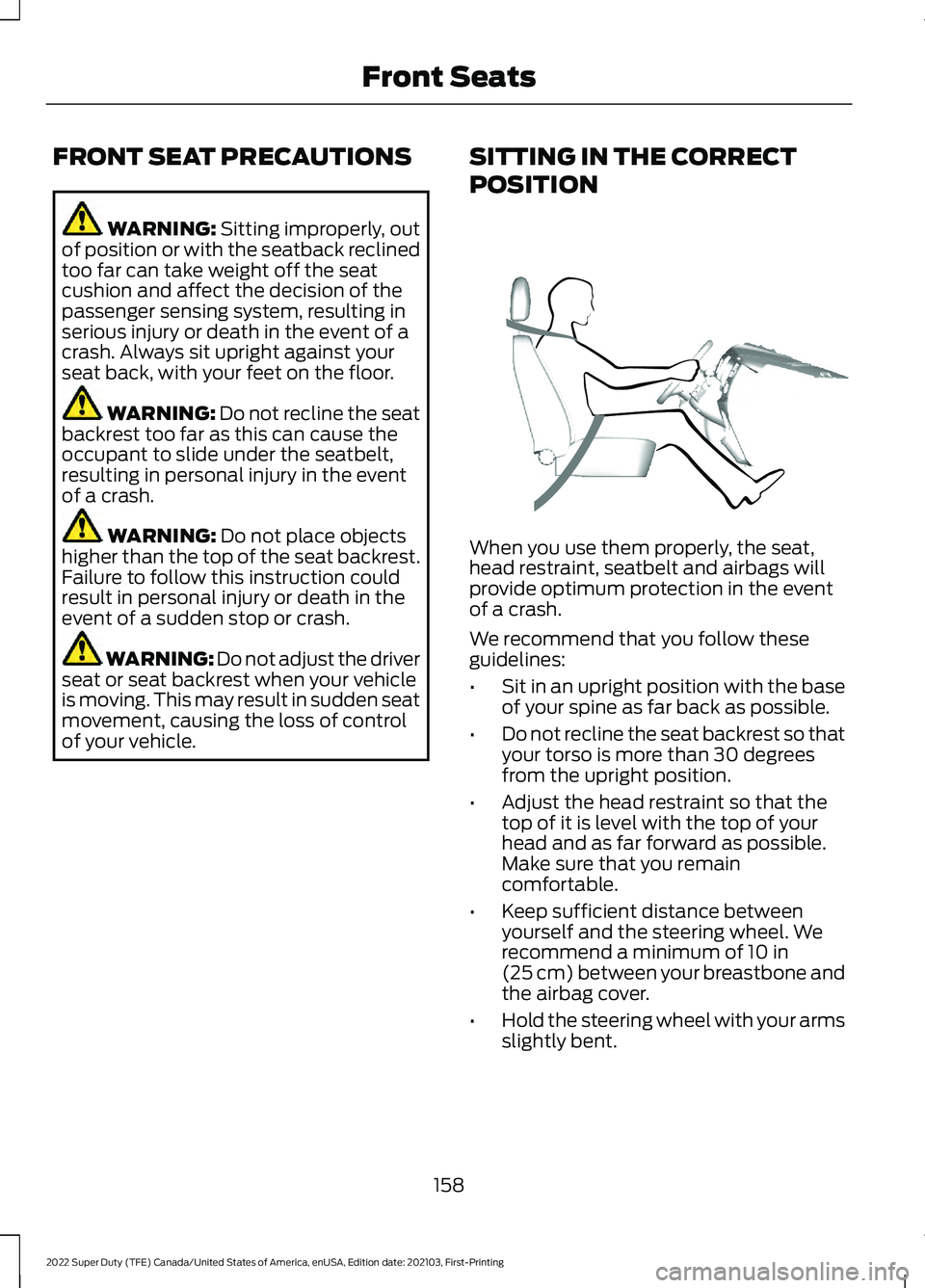
FRONT SEAT PRECAUTIONS
WARNING: Sitting improperly, out
of position or with the seatback reclined
too far can take weight off the seat
cushion and affect the decision of the
passenger sensing system, resulting in
serious injury or death in the event of a
crash. Always sit upright against your
seat back, with your feet on the floor. WARNING: Do not recline the seat
backrest too far as this can cause the
occupant to slide under the seatbelt,
resulting in personal injury in the event
of a crash. WARNING:
Do not place objects
higher than the top of the seat backrest.
Failure to follow this instruction could
result in personal injury or death in the
event of a sudden stop or crash. WARNING: Do not adjust the driver
seat or seat backrest when your vehicle
is moving. This may result in sudden seat
movement, causing the loss of control
of your vehicle. SITTING IN THE CORRECT
POSITION When you use them properly, the seat,
head restraint, seatbelt and airbags will
provide optimum protection in the event
of a crash.
We recommend that you follow these
guidelines:
•
Sit in an upright position with the base
of your spine as far back as possible.
• Do not recline the seat backrest so that
your torso is more than 30 degrees
from the upright position.
• Adjust the head restraint so that the
top of it is level with the top of your
head and as far forward as possible.
Make sure that you remain
comfortable.
• Keep sufficient distance between
yourself and the steering wheel. We
recommend a minimum of
10 in
(25 cm) between your breastbone and
the airbag cover.
• Hold the steering wheel with your arms
slightly bent.
158
2022 Super Duty (TFE) Canada/United States of America, enUSA, Edition date: 202103, First-Printing Front SeatsE68595
Page 167 of 740
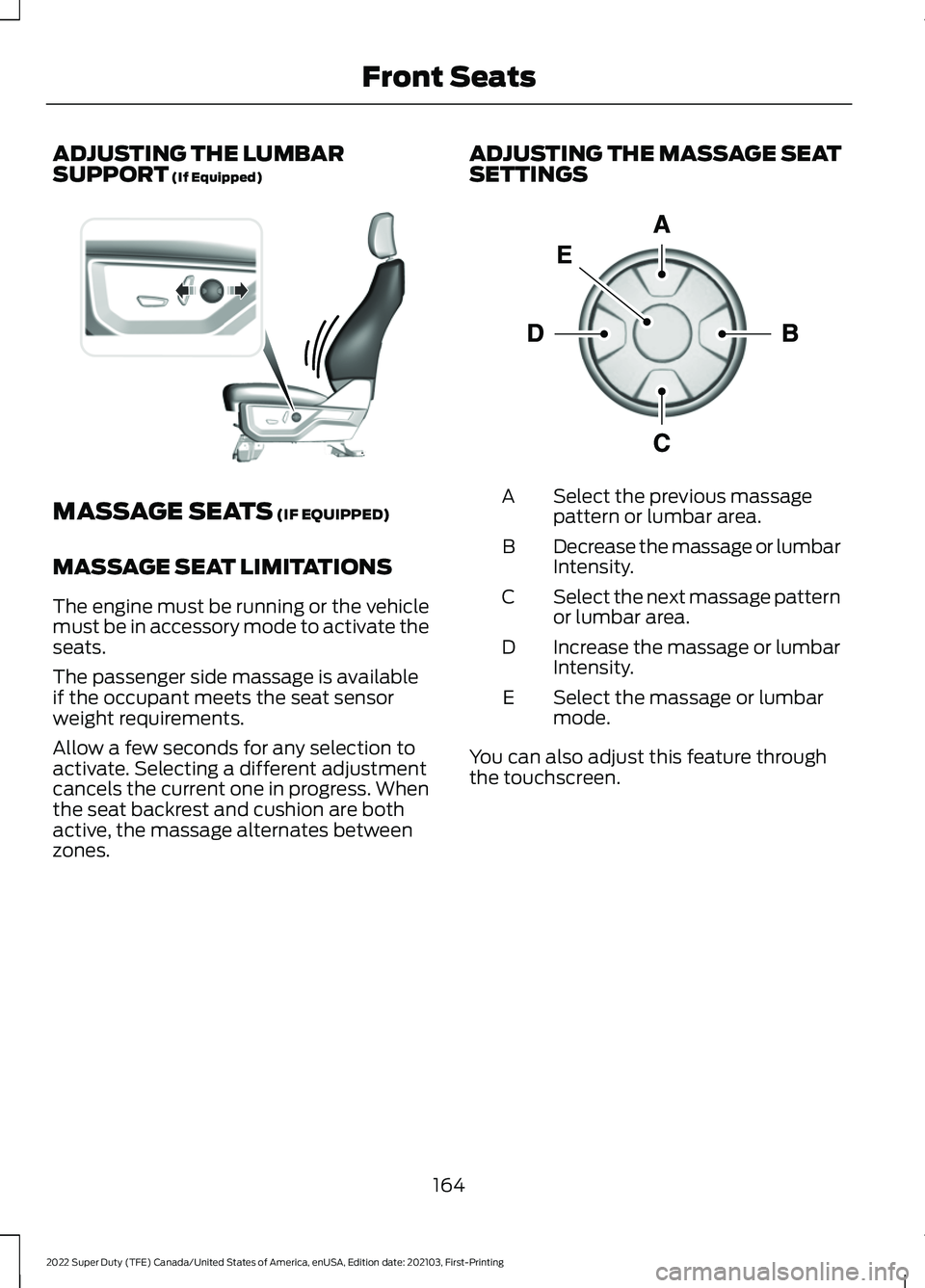
ADJUSTING THE LUMBAR
SUPPORT (If Equipped)
MASSAGE SEATS
(IF EQUIPPED)
MASSAGE SEAT LIMITATIONS
The engine must be running or the vehicle
must be in accessory mode to activate the
seats.
The passenger side massage is available
if the occupant meets the seat sensor
weight requirements.
Allow a few seconds for any selection to
activate. Selecting a different adjustment
cancels the current one in progress. When
the seat backrest and cushion are both
active, the massage alternates between
zones. ADJUSTING THE MASSAGE SEAT
SETTINGS Select the previous massage
pattern or lumbar area.
A
Decrease the massage or lumbar
Intensity.
B
Select the next massage pattern
or lumbar area.
C
Increase the massage or lumbar
Intensity.
D
Select the massage or lumbar
mode.
E
You can also adjust this feature through
the touchscreen.
164
2022 Super Duty (TFE) Canada/United States of America, enUSA, Edition date: 202103, First-Printing Front SeatsE327927 E156301
Page 197 of 740
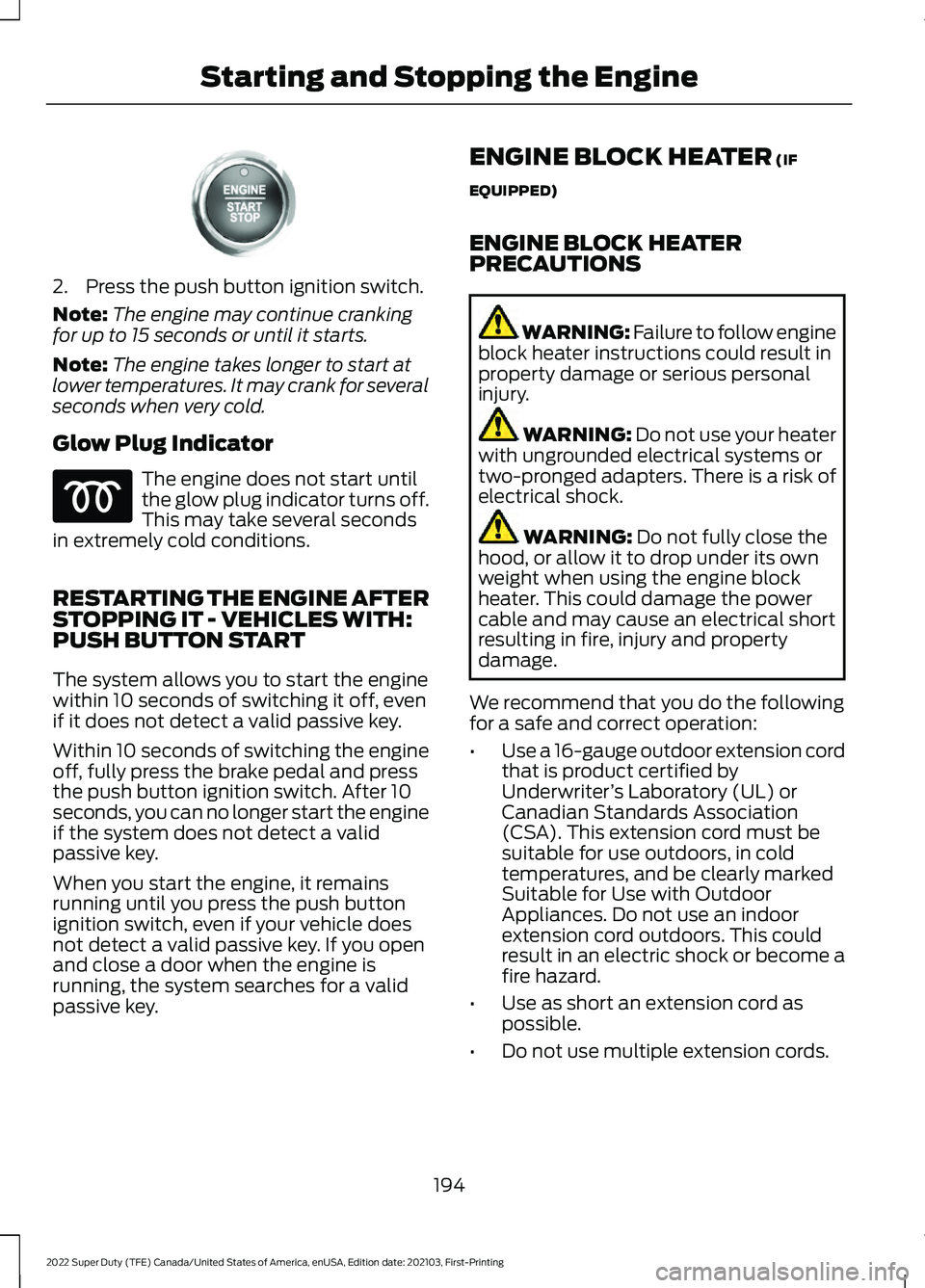
2. Press the push button ignition switch.
Note:
The engine may continue cranking
for up to 15 seconds or until it starts.
Note: The engine takes longer to start at
lower temperatures. It may crank for several
seconds when very cold.
Glow Plug Indicator The engine does not start until
the glow plug indicator turns off.
This may take several seconds
in extremely cold conditions.
RESTARTING THE ENGINE AFTER
STOPPING IT - VEHICLES WITH:
PUSH BUTTON START
The system allows you to start the engine
within 10 seconds of switching it off, even
if it does not detect a valid passive key.
Within 10 seconds of switching the engine
off, fully press the brake pedal and press
the push button ignition switch. After 10
seconds, you can no longer start the engine
if the system does not detect a valid
passive key.
When you start the engine, it remains
running until you press the push button
ignition switch, even if your vehicle does
not detect a valid passive key. If you open
and close a door when the engine is
running, the system searches for a valid
passive key. ENGINE BLOCK HEATER (IF
EQUIPPED)
ENGINE BLOCK HEATER
PRECAUTIONS WARNING:
Failure to follow engine
block heater instructions could result in
property damage or serious personal
injury. WARNING: Do not use your heater
with ungrounded electrical systems or
two-pronged adapters. There is a risk of
electrical shock. WARNING:
Do not fully close the
hood, or allow it to drop under its own
weight when using the engine block
heater. This could damage the power
cable and may cause an electrical short
resulting in fire, injury and property
damage.
We recommend that you do the following
for a safe and correct operation:
• Use a 16-gauge outdoor extension cord
that is product certified by
Underwriter ’s Laboratory (UL) or
Canadian Standards Association
(CSA). This extension cord must be
suitable for use outdoors, in cold
temperatures, and be clearly marked
Suitable for Use with Outdoor
Appliances. Do not use an indoor
extension cord outdoors. This could
result in an electric shock or become a
fire hazard.
• Use as short an extension cord as
possible.
• Do not use multiple extension cords.
194
2022 Super Duty (TFE) Canada/United States of America, enUSA, Edition date: 202103, First-Printing Starting and Stopping the EngineE321258
Page 246 of 740
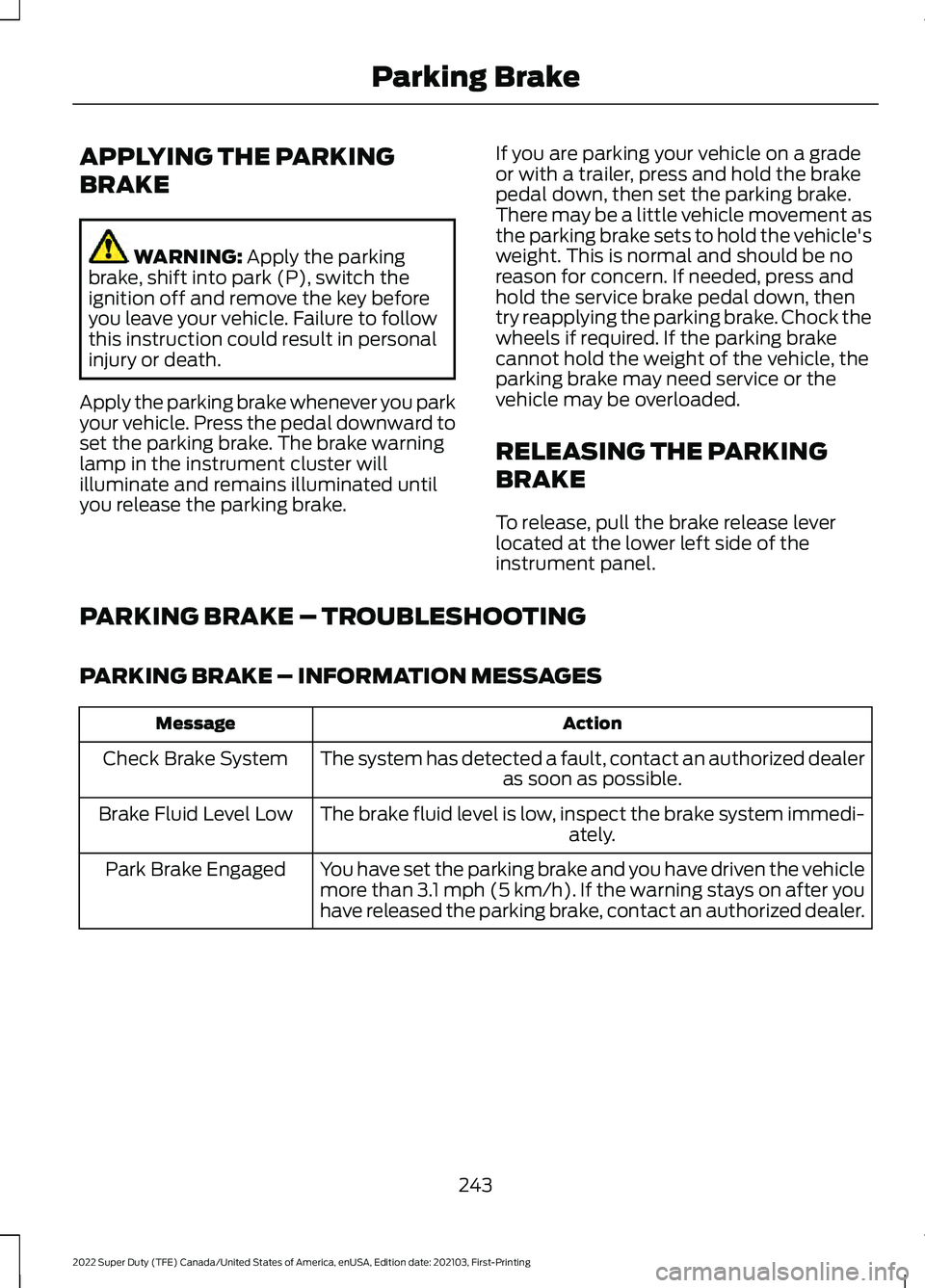
APPLYING THE PARKING
BRAKE
WARNING: Apply the parking
brake, shift into park (P), switch the
ignition off and remove the key before
you leave your vehicle. Failure to follow
this instruction could result in personal
injury or death.
Apply the parking brake whenever you park
your vehicle. Press the pedal downward to
set the parking brake. The brake warning
lamp in the instrument cluster will
illuminate and remains illuminated until
you release the parking brake. If you are parking your vehicle on a grade
or with a trailer, press and hold the brake
pedal down, then set the parking brake.
There may be a little vehicle movement as
the parking brake sets to hold the vehicle's
weight. This is normal and should be no
reason for concern. If needed, press and
hold the service brake pedal down, then
try reapplying the parking brake. Chock the
wheels if required. If the parking brake
cannot hold the weight of the vehicle, the
parking brake may need service or the
vehicle may be overloaded.
RELEASING THE PARKING
BRAKE
To release, pull the brake release lever
located at the lower left side of the
instrument panel.
PARKING BRAKE – TROUBLESHOOTING
PARKING BRAKE – INFORMATION MESSAGES Action
Message
The system has detected a fault, contact an authorized dealer as soon as possible.
Check Brake System
The brake fluid level is low, inspect the brake system immedi- ately.
Brake Fluid Level Low
You have set the parking brake and you have driven the vehicle
more than 3.1 mph (5 km/h). If the warning stays on after you
have released the parking brake, contact an authorized dealer.
Park Brake Engaged
243
2022 Super Duty (TFE) Canada/United States of America, enUSA, Edition date: 202103, First-Printing Parking Brake